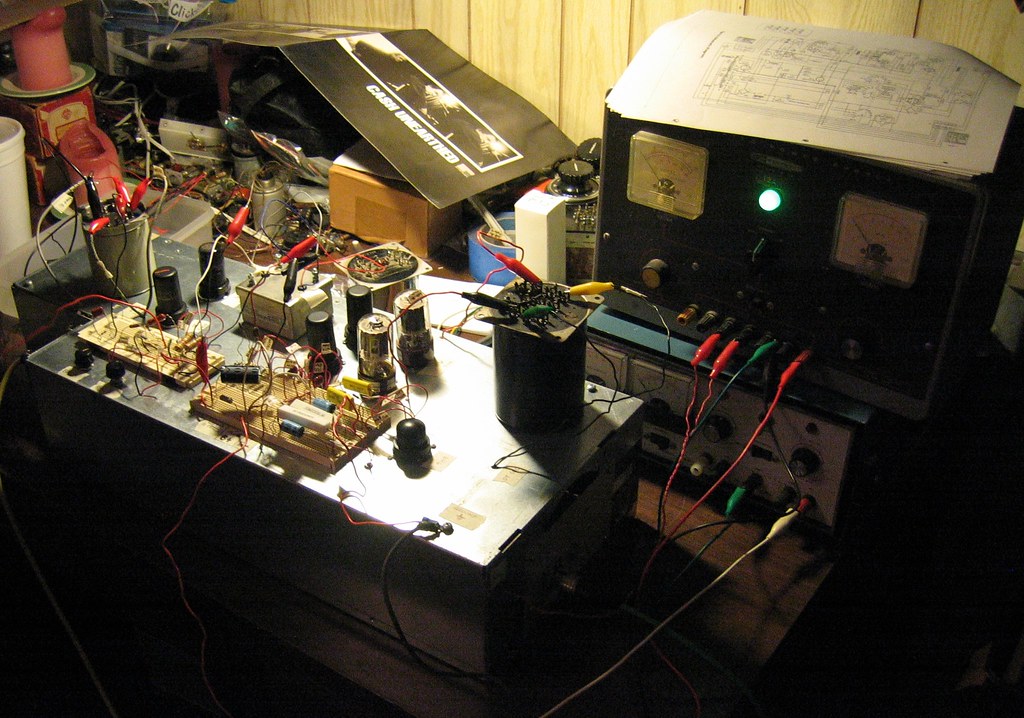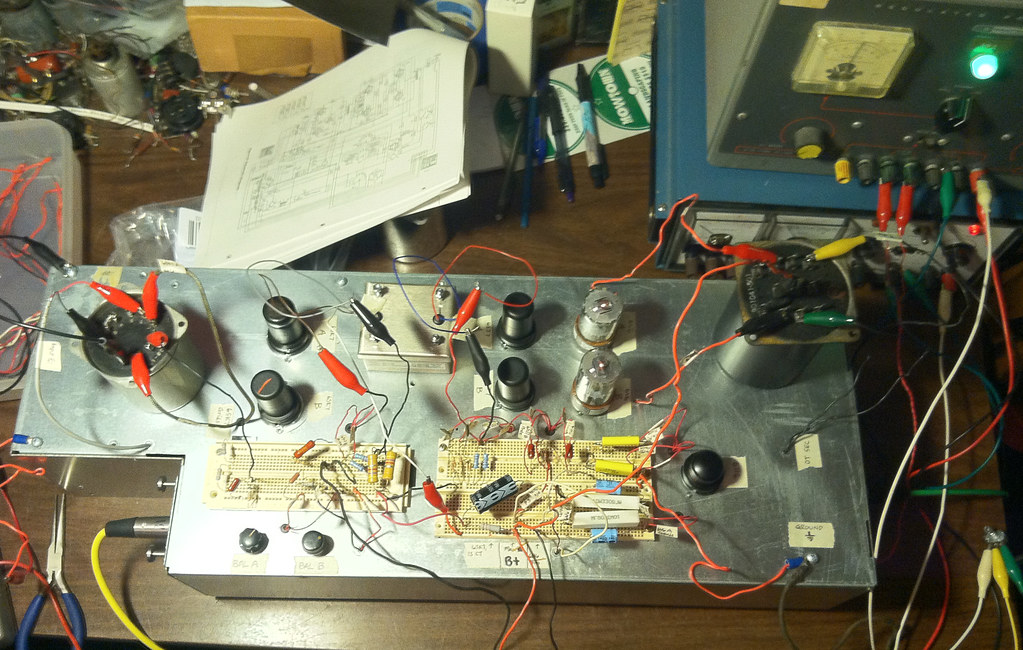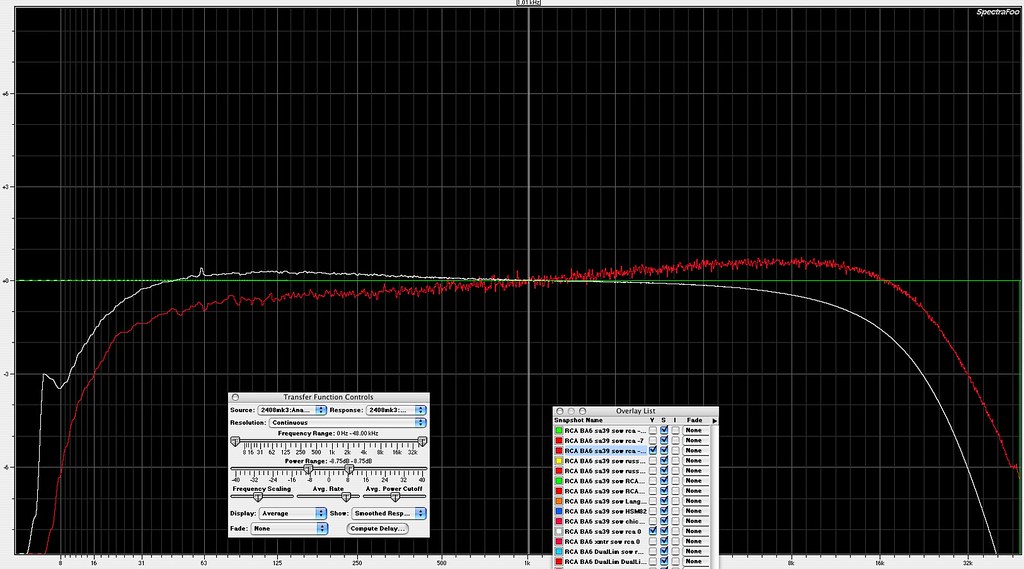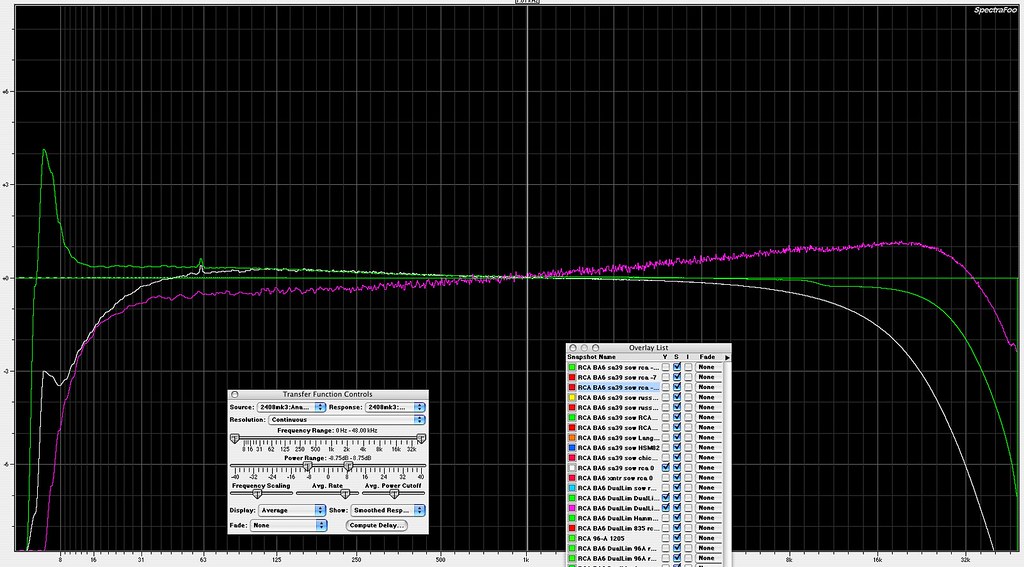You are using an out of date browser. It may not display this or other websites correctly.
You should upgrade or use an alternative browser.
You should upgrade or use an alternative browser.
Ba6a interstage
- Thread starter baadc0de
- Start date
Help Support GroupDIY Audio Forum:
This site may earn a commission from merchant affiliate
links, including eBay, Amazon, and others.
Woot
Well-known member
Hey Guys,
This might not be useful, but I will have the Drip Ba6a up and running soon with the Sowter offerings...
If it would be handy to have any measurements from this application/circuit for comparison to the measurements in the test circuit and anyone is patient enough to talk me through it, then I'd be happy to do some.
Otherwise.... carry on
Cheers,
Matt
This might not be useful, but I will have the Drip Ba6a up and running soon with the Sowter offerings...
If it would be handy to have any measurements from this application/circuit for comparison to the measurements in the test circuit and anyone is patient enough to talk me through it, then I'd be happy to do some.
Otherwise.... carry on
Cheers,
Matt
If it would be handy to have any measurements from this application/circuit for comparison to the measurements in the test circuit and anyone is patient enough to talk me through it, then I'd be happy to do some.
Yes, it would be very good to have another set of measurements for comparison. Thanks.
mitsos said:Can you guys also measure inductance and DCR please?
Pri half 1: 361 ohms, 31.2H
Pri half 2: 355 ohms, 31.3H, Pri full 119H
Sec: 715 ohms, 20.64H ***Correction*** Sec L = 120.64 H
L measured @ 120Hz with handheld meter.
mitsos said:Oh cool, thanks... That secondary looks weird though... Typo? Is that really 20H, not 120?
10K:10K must have the same turns count, so inductance should also be the same more or less.
oops - yes that is typo. 120H is correct for sec. Will edit post
All testing was completed today and emrr will be along with the results shortly. 8)
Though it's not the central focus of this thread I wanted to mention that the testing gave coverage to OT candidates as well.
The clue: 2X 100K r + 2X 1.0uF = about 85 cents . . . . from there I'd say you're pretty much free to be cowboys.
Though it's not the central focus of this thread I wanted to mention that the testing gave coverage to OT candidates as well.
The clue: 2X 100K r + 2X 1.0uF = about 85 cents . . . . from there I'd say you're pretty much free to be cowboys.
Lassoharp and I ran tests on a lot of different transformers in a BA-6 test bed he built. We powered it with several bench supplies so as to dial in voltages precisely, and took measurements with no gain reduction, and up to 11dB gain reduction, pink noise as source. We used a Gates SA-39 input transformer for some tests, and a Gates Dual Limiter input for others. We looked at a bunch of different outputs, and noted the feedback seems to make the outputs look mostly the same on the bottom end, though top end differences did exist. We also looked at a multitude of possible interstage transformers. We did not find need to tweak GR balance to any great extent, perhaps we got lucky with our selection of GR tubes.


The #1 question regarding the quality of the Sowter interstage transformer seems to have been answered satisfactorily; it seems to perform fine.
Both plots show an original RCA output transformer.
For all examples, gain reduction tilts the response toward the treble end.
This is an SA-39 input, Sowter interstage, and RCA output, with 0 and -11 GR matched at 1K for comparison.

This is a Gates Dual Limiter input and interstage with same RCA output, 0 and -11 GR matched at 1K for comparison, SA-39/Sowter/RCA/no GR left for comparison. I show this one because 1) Dual Limiter is very close to the BA-6 gain reduction stage and 2) the Dual Limiter input transformer has greater top end extension than the older SA-39 input.

UTC A-18 works OK when run backwards, but the step down ratio means you get less limiting and it automatically lowers the max ratio before input overload. We tested an RCA 86 limiter interstage and it also worked fine, same step down ratio issue though. You really want a 1:1 here or limiting action will not be correct.
In general all the oddball interstages worked fine so long as they had passed initial assessment for inductance. Shopping for such would be a crapshoot, with so many specs unknown until in hand and measured.


The #1 question regarding the quality of the Sowter interstage transformer seems to have been answered satisfactorily; it seems to perform fine.
Both plots show an original RCA output transformer.
For all examples, gain reduction tilts the response toward the treble end.
This is an SA-39 input, Sowter interstage, and RCA output, with 0 and -11 GR matched at 1K for comparison.

This is a Gates Dual Limiter input and interstage with same RCA output, 0 and -11 GR matched at 1K for comparison, SA-39/Sowter/RCA/no GR left for comparison. I show this one because 1) Dual Limiter is very close to the BA-6 gain reduction stage and 2) the Dual Limiter input transformer has greater top end extension than the older SA-39 input.

UTC A-18 works OK when run backwards, but the step down ratio means you get less limiting and it automatically lowers the max ratio before input overload. We tested an RCA 86 limiter interstage and it also worked fine, same step down ratio issue though. You really want a 1:1 here or limiting action will not be correct.
In general all the oddball interstages worked fine so long as they had passed initial assessment for inductance. Shopping for such would be a crapshoot, with so many specs unknown until in hand and measured.
Woot
Well-known member
Interesting stuff Doug, thanks.
For an electronics newbie, could someone explain why the Sowter, even with markedly lower inductance, performs similarly to the other interstages in this circuit? Is it the way it is implemented in the Ba6a?
Cheers,
Matt
For an electronics newbie, could someone explain why the Sowter, even with markedly lower inductance, performs similarly to the other interstages in this circuit? Is it the way it is implemented in the Ba6a?
Cheers,
Matt
We also did not measure L on stock BA6A interstage, only 86B interstage. They may be similar, may not. The 86B doesn't use neg feedback like the BA-6 does.
Some more discussion. Sounds like minimum is just above 100H for BA6A factory response spec.
http://groupdiy.com/index.php?topic=44312.msg562225#msg562225
We did pass music through the test circuit at an unknown GR. Sounded excellent - sounded like a good tube compressor at work. Whatever distortion on the bottom that was there was not gross. I believe the combo we listened on was Gates Dual input, Sowter IS, BA6A OT.
Some more discussion. Sounds like minimum is just above 100H for BA6A factory response spec.
http://groupdiy.com/index.php?topic=44312.msg562225#msg562225
We did pass music through the test circuit at an unknown GR. Sounded excellent - sounded like a good tube compressor at work. Whatever distortion on the bottom that was there was not gross. I believe the combo we listened on was Gates Dual input, Sowter IS, BA6A OT.
Thanks for getting more info about this subject out into the open  transformers can be such a touchy subject.. decades old ones meant for tube gear even more so.
transformers can be such a touchy subject.. decades old ones meant for tube gear even more so.
I'll get around building a BA6A and am thinking about the Sowter interstage. I wouldn't want to overstay my welcome, but but is there any way you guys could measure test tone THD at bass frequencies as well?
I'll get around building a BA6A and am thinking about the Sowter interstage. I wouldn't want to overstay my welcome, but but is there any way you guys could measure test tone THD at bass frequencies as well?
baadc0de said:Thanks for getting more info about this subject out into the opentransformers can be such a touchy subject.. decades old ones meant for tube gear even more so.
I'll get around building a BA6A and am thinking about the Sowter interstage. I wouldn't want to overstay my welcome, but but is there any way you guys could measure test tone THD at bass frequencies as well?
I would go with Sowter's published level handling spec and start by assuming it is stated for the lowest freq of interest. It's probably worth asking Brian Sowter to confirm if that assumption is correct or not. May even be some data sheets on file for that. I would think that THD vs freq would be something that could be reliably tested out of circuit on the bench so his specs should translate to the real circuit in that regard. If there are still any doubts, I'm keeping the test circuit as is for a while and plan on using it for testing my own version so possibly in the future we could run some THD measurements just for sake of compiling data.
Of course, use an input transformer that has level handling spec that suits your end needs. Overloading at that point makes everything downstream a lot less relevant.
One other way to look at the situation - if the Sowter's THD specs on the bottom aren't acceptable then the only reasonable alternative would be a Doc Hoyer build from scratch replica - with no guarantees on how that would measure compared to Sowter. And that option would likely be a >>> than 200USD option simply due to the massive labor cost of the job. The lams he would use are 50/50 Ni that any DIY winder could purchase.
After yesterday's test I view the Sowter as a solid option for making a True Blue BA-A clone that won't leave you coming up short on the bottom. I think the bottlneck is officially a dead duck.
No one has mentioned a Lundahl LL1635 for the interstage, why is that?
It would be good to know the interstage inductance. If the replacement interstage versus the original interstage's inductance is way off then the reactance of the primary winding half plus the 40uF capacitor will be increased and the filter impedance reduced. That will alter the low frequency distortion to a more or lesser degree along the response.
It would be good to know the interstage inductance. If the replacement interstage versus the original interstage's inductance is way off then the reactance of the primary winding half plus the 40uF capacitor will be increased and the filter impedance reduced. That will alter the low frequency distortion to a more or lesser degree along the response.
LL1635 certainly looks like it would work fine, it has higher L than many we tried. Also roughly half the price of the Sowter in US$.
----edit-----
looking at source Z spec, DC resistance, and headroom, it's really a 'power' class device. Someone would have to try it and confirm.
----end edit-----
I would add that L tends to appear through the roof on most old RCA iron, so much as to be sure low frequency distortion is not an issue. A replacement may appear vastly lower, and still perform well.
I would also add that in out tests we listened with the limiter crossing the curve from flatline limiting to outright overload distortion, and overload distortion was the only distortion detectable to the ear. I heard no preliminary response alterations before the entire amp overloaded, and I specifically picked some sources with significant bass drum extension that occurred on a sparse basis, so any abnormality around an occasional low frequency event would have been obvious. I have heard many stock tube limiters perform worse than this test bed, or any of the transformers we tried.
----edit-----
looking at source Z spec, DC resistance, and headroom, it's really a 'power' class device. Someone would have to try it and confirm.
----end edit-----
I would add that L tends to appear through the roof on most old RCA iron, so much as to be sure low frequency distortion is not an issue. A replacement may appear vastly lower, and still perform well.
I would also add that in out tests we listened with the limiter crossing the curve from flatline limiting to outright overload distortion, and overload distortion was the only distortion detectable to the ear. I heard no preliminary response alterations before the entire amp overloaded, and I specifically picked some sources with significant bass drum extension that occurred on a sparse basis, so any abnormality around an occasional low frequency event would have been obvious. I have heard many stock tube limiters perform worse than this test bed, or any of the transformers we tried.
MatthisD said:No one has mentioned a Lundahl LL1635 for the interstage, why is that?
It would be good to know the interstage inductance. If the replacement interstage versus the original interstage's inductance is way off then the reactance of the primary winding half plus the 40uF capacitor will be increased and the filter impedance reduced. That will alter the low frequency distortion to a more or lesser degree along the response.
No particular reason that I can think of in general. I usually don't look at Lundahl because I build mostly p to p chassis mount style and mounting potted iron fits best with that. After looking at the spec sheet . . . . well, looks excellent and a C-Core. Nice. Half the cost of Sowter for US buyers. Extra Nice. Just about can't afford not to try one.
The focus of the tests were to answer the question of whether the Sowter met response spec in a real BA6 circuit, hence the trouble of building a real one up to use as a test bed. Part of the confusion and doubt stemmed from a couple things - no one else who had used one ever took any measurements and published them. Secondly, there were at least two individuals who had used the Sowter 86B interstage in real factory units (86/96) and were getting abysmal performance on the bottom. Different circuits of course but worth investigating considering the cost and the limited other options. Now we know - it doesn't require anything super special or esoteric with some monstrously high L to perform properly and sound really good. It sounds like Sowter met the minimum L spec and pitted that against cost and there you have it.
If there is a round two of testing that looks at THD way way down at 30Hz all we will have are some numbers - percents. The rest would seem to fall in the subjective realm IMO. And we already know that iron will smaller level handling capacity will likely give a higher number there. What we have no idea of is whether that will be a dealbreaker for someone or whether they will rush out the door to track one down asap. It could easily go both ways. Opinions? Worth testing? Or are sound files a better route?
Similar threads
- Replies
- 2
- Views
- 498
- Replies
- 7
- Views
- 819
Latest posts
-
-
-
-
-
Neumann M49 Clone : Build Thread Puck Style (TLM49 Conversion To M49 b-c)
- Latest: Spencerleehorton
-
-
-

































